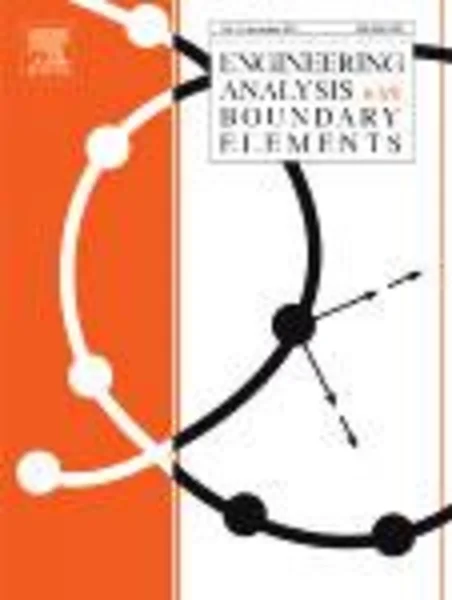-
hybrid and collocation trefftz methods for traction boundary conditions in linear elastostatics
جزئیات بیشتر مقاله- تاریخ ارائه: 1390/01/01
- تاریخ انتشار در تی پی بین: 1390/01/01
- تعداد بازدید: 689
- تعداد پرسش و پاسخ ها: 0
- شماره تماس دبیرخانه رویداد: -
for linear elastostatics, the particular solutions and the fundamental solutions can be used for the admissible functions, so that only the boundary conditions need to be satisfied, thus called the boundary methods (or trefftz methods). hence, how to couple the boundary conditions is a crucial issue. there are basically two types of boundary conditions: (i) the displacement (i.e., dirichlet) condition and (ii) the traction (i.e., neumann) condition. in this paper, the coupling techniques for the traction (i.e., neumann condition) are the main theme for boundary methods, because the traction condition may be regarded as the basic condition and the displacement condition as the natural condition. the lagrange multiplier used for the displacement (i.e., dirichlet) condition is well known in mathematics community (see babuška, 1973 ; babuška et al., 1978 ; li, 1998 ; pitkäranta, 1979 ), but the lagrange multiplier used for the traction (i.e., neumann) condition is popular for elasticity problems by the trefftz method in engineering community, which is called the hybrid trefftz method (htm) (see de freitas, 1998 ; de freitas and ji, 1996 and ; jirousek, 1978 ; jirousek and venkstesh, 1992; jirousek and wroblewski, 1996 ; qin, 2000 ). on the other hand, the collocation trefftz method (ctm) can also be used to directly couple the traction condition without extra-multipliers. in this paper, a brief error analysis for the htm is given, to provide the optimal convergence rates. numerical experiments of simple models are carried out to support this analysis. the htm has the merits: flexibility and robustness, so that it has been widely used in engineering problems. since the optimal convergence rates are the most important criterion in evaluation of numerical methods, the global performance of the htm is as good as that of the ctm, although the htm causes larger condition numbers and requires more ctu time for the computation of the simple models in this paper. more numerical comparisons also show that using the particular solutions is more advantageous than using the fundamental solutions in both htm and ctm.
مقالات جدیدترین رویدادها
-
استفاده از تحلیل اهمیت-عملکرد در ارائه الگوی مدیریت خلاقیت سازمانی و ارائه راهکار جهت بهبود
-
بررسی تاثیر ارزش وجوه نقد مازاد بر ساختار سرمایه شرکت های پذیرفته شده در بورس اوراق بهادار تهران
-
بررسی تأثیر سطح افشای ریسک بر قرارداد بدهی شرکت های پذیرفته شده در بورس اوراق بهادار تهران
-
بررسی تأثیر رتبه بندی اعتباری مبتنی بر مدل امتیاز بازار نوظهور بر نقد شوندگی سهام با تأکید بر خصوصی سازی شرکت ها
-
تأثیر آمیخته بازاریابی پوشاک ایرانی بر تصویر ذهنی مشتری پوشاک ایرانی (هاکوپیان)
-
تحلیل جایگاه بیت کوین در نظام بانکداری اسلامی
-
پایش سلامت سازه ها با استفاده از شبکه های عصبی
-
مضامین تعلیمی متأثر از عرفان در مختار نامه عطار
-
بازنگری روش آموزش مبحث نسبت ها تناسب و درصد گیری براساس روش تجزیه (درس پژوهی( و بررسی تاثیر آن بر عملکرد دانش آموزان
-
بررسی ارتباط ریزساختار و رفتار ترد شوندگی در تحلیل شکست لوله های انتقال از جنس api 5lx60
مقالات جدیدترین ژورنال ها
-
مدیریت و بررسی افسردگی دانش آموزان دختر مقطع متوسطه دوم در دروان کرونا در شهرستان دزفول
-
مدیریت و بررسی خرد سیاسی در اندیشه ی فردوسی در ادب ایران
-
واکاوی و مدیریت توصیفی قلمدان(جاکلیدی)ضریح در موزه آستان قدس رضوی
-
بررسی تاثیر خلاقیت، دانش و انگیزه کارکنان بر پیشنهادات نوآورانه کارکنان ( مورد مطالعه: هتل های 3 و 4 ستاره استان کرمان)
-
بررسی تاثیر کیفیت سیستم های اطلاعاتی بر تصمیم گیری موفق در شرکتهای تولیدی استان اصفهان (مورد مطالعه: مدیران شرکتهای تولیدی استان اصفهان)
-
آینده نگاری توسعه زیرساخت های فناوری اطلاعات و ارتباطات کشور در فضای مجازی با تأکید بر روش سناریو
-
ساخت و بررسی ویژگی های روان سنجی مقیاس کوتاه اضطراب دفاع از پایان نامه تحصیلی (ats-bf) در دانشجویان ایرانی: تحلیل عاملی اکتشافی
-
شناسایی و اولویت بندی عوامل موثر در ایجاد فرهنگ استفاده از کالای داخلی در بین دانش آموزان دوره ابتدایی
-
بررسی تأثیر بیش اعتمادی مدیران بر چسبندگی هزینه ها در شرکت های پذیرفته شده در بورس اوراق بهادار تهران
-
مروری بر عوامل فرسودگی شغلی و راهکارهای درمان آن




سوال خود را در مورد این مقاله مطرح نمایید :